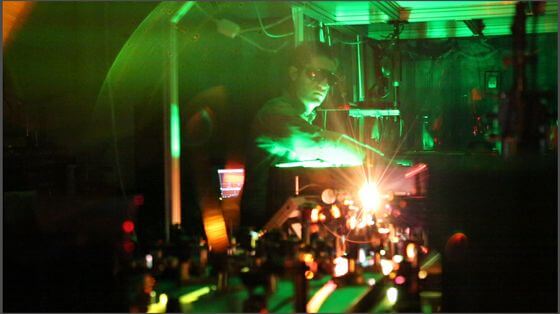When most people think about lasers, they usually imagine them generating heat and even setting something on fire. But, for a group of scientists in The University of New Mexico’s Department of Physics & Astronomy, lasers are actually being used to reach temperatures colder than the arctic circle.
Dr. Mansoor Sheik-Bahae, professor of physics and astronomy, along with his research group, are advancing a technique called optical refrigeration to reach cryogenic temperature. Essentially, the group is using laser light to chill a special type of crystal, which can then be attached to a device that requires constant and reliable cooling, like infrared detectors on satellites. What sets their technique apart is the temperatures it can cool to without having any moving parts.
“Right now, anything that cools other parts of a system has moving parts. Most of the time, there’s liquid running through it that adds vibrations which can impact the precision or resolution of the device,” explained Aram Gragossian, a research assistant in Sheik-Bahae’s lab. “But, when you have optical refrigeration, you can go to low temperatures without any vibrations and without any moving parts, making it convenient for a lot of applications.”
Earlier this year, Sheik-Bahae, along with collaborators at UNM, and Los Alamos National Labs, reached the lowest temperatures ever recorded using an all-solid-state cryocooler – 91 kelvin or -296o Fahrenheit – temperatures that were previously only able to be reached using liquid nitrogen or helium. The research, Solid-state optical refrigeration to sub-100 Kelvin regime, was published in the journal of (Nature) Scientific Reports 6.
“Here at UNM, we are the only group in the world that’s been able to cool to cryogenic temperatures with an all-solid-state optical cryocooler,” said Alexander Albrecht, one of the paper’s co-authors and research assistant professor at UNM.
“We are really on the cutting edge when it comes to solid-state laser cooling,” said Sheik-Bahae. “While achieving major milestones in the fundamental science aspect of this field, in parallel, we are making rapid advances in implementing this technology for real world applications. For example, in partnership with a NM startup (founded by one of pioneers on the field, Richard Epstein), we are developing the world’s first all-solid-state cryocooler device”
This latest achievement is the product of more than 20 years of work by researchers at UNM, the University of Pisa in Italy and New Mexico’s national laboratories. In 1995, researchers at Los Alamos accomplished cooling of about one degree. Since then, through vast improvements in the purity of synthetic crystals containing Ytterbium ions and the lasers being shot at them, UNM scientists have been able to continue cooling to colder and colder temperatures.
“We were able to identify what kinds of crystals can be used for this. And, in collaboration with Los Alamos National Labs and a few other universities, we finally found crystals that can cool to these extreme temperatures,” said Gragossian.
Moving forward, Sheik-Bahae and his team hope to continue working on the cutting edge of this technology to achieve even colder temperatures; something they believe will have a major impact in a variety of industries and applications.
One function of solid-state cryocoolers is to cool infrared focal plane arrays (cameras), which can be used for a variety of applications and are even being utilized to detect skin cancer in patients. The detectors must be able to read miniscule changes between healthy areas of skin and diseased areas, so having a cooling system that does not generate vibrations could be extremely useful.
Another application that is being currently developed in collaboration with the scientists at the National Institute of Standards and Technology (NIST) in Colorado is cooling of delicate “reference cavities” for achieving super-stable lasers that will be used as high precision clocks in myriad of metrology applications.
While these examples are just a few of the potential uses for solid-state cryocoolers, the opportunities are endless and could change the way cooling devices are utilized around the world.


You got to push it-this esenitsal info that is!
There is a typographic anomaly in the article. The dash used to denote an interjection could be confused with an attempt to indicate a temperature below absolute zero. “- 91 […] -” looks like “-91”
Even with windchill; I don’t think that is possible, except in Futurama.